‘Who owns the river?’: Wilmington residents call for historic dam protection while environmentalists work to protect fish species
Residents of a gated community in Delaware say they’re worried they could lose their beloved waterfall, and a piece of history, if a dam is removed to protect fish species.
Listen 4:41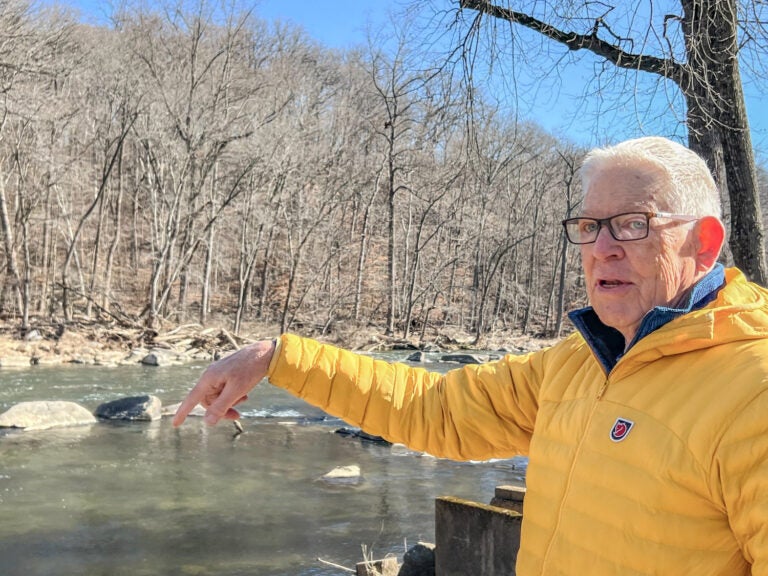
Brandywine Falls resident Bob Hurka said he enjoys the peaceful views of the waterfall near his home. He's been calling for the dam that creates rushing water to remain. (Zoë Read/WHYY)
From Philly and the Pa. suburbs to South Jersey and Delaware, what would you like WHYY News to cover? Let us know!
Bob Hurka has lived in the gated community of Brandywine Falls in Wilmington, Del., for three years.
He only has to look through the floor-to-ceiling windows of his living room to enjoy peaceful views of Brandywine Creek. Hurka enjoys watching birds as they land on rocks adorning the glistening waterway.
“It feels like you’re in the Nature Channel 24 hours a day,” he said.

But the best feature of the river, Hurka said, is the rustling waterfall, created by a dam built in the 19th century. On the opposite side of the 3,500-square-foot condominiums, people often picnic by the waterfall after a trek through Alapocas Run State Park, he said.
“It’s very peaceful. The sound is very pleasing,” Hurka said. “It’s a tremendous feature of this area, and there are a lot of people who hike up there to enjoy it.”
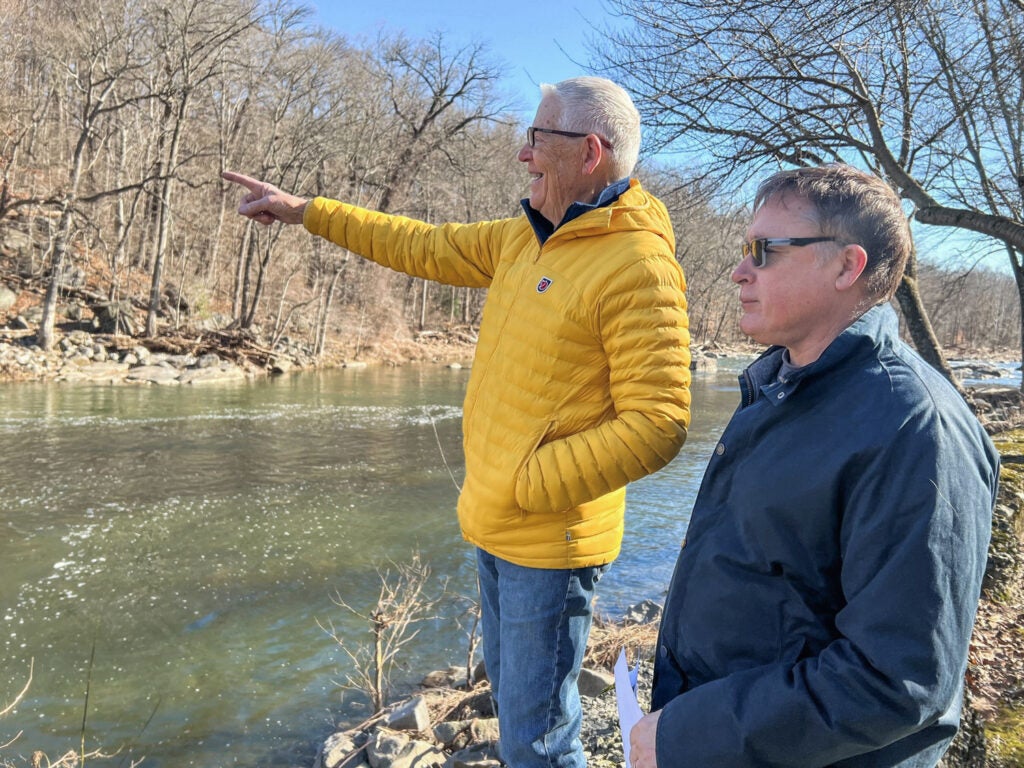
But he and other Brandywine Falls residents say they’re worried about the future of the waterfall. For several years, environmental advocates and agencies have proposed removing some dams along the Brandywine for a number of reasons.
Some of the dams are falling apart, posing a public safety hazard if they were ever to burst during a major flooding event. Dams built before the latter part of the 20th century may also be prone to raising water levels even higher during storms, some scientists say.
The structures also prevent migratory fish, such as American shad, from moving freely along the river to reproduce.
Brandywine River Restoration Trust, an environmental advocacy group, has led the charge to restore fish passage along the Brandywine. Those efforts could include installing rock ramps that simulate natural rapids to help fish pass, or removing dams entirely.
Two damaged dams along the Brandywine have recently been approved for removal.
The U.S. Army Corps of Engineers is studying the dam behind Brandywine Falls to determine whether it’s a good candidate for removal.
Though the agency hasn’t made a decision, residents are concerned they could lose their waterfall —- and a piece of 19th-century history. The dam was a major part of industrial development along the Brandywine, providing energy for textile manufacturing.
Resident and homeowner’s association treasurer Frank Ursomarso said his community should have greater say about what happens to the dam, which is owned by the city and state.
“We think there’s an obligation to engage the entire community — which doesn’t mean just people living on the river, or people who [have been] flooded. It’s everybody who has an opportunity to use the creek and the parks,” said Ursomarso.
But Jim Shanahan, executive director of Brandywine River Restoration Trust, argues the benefits of dam removal often outweigh the losses.
“It is for the greater good,” said Shanahan. “These benefits that accrue, such as habitat restoration, or saving a particular species, improving public safety and reducing flooding … far outweigh the interest of a select group of people to view or listen to a man-made element that is over a couple of hundred years old.”
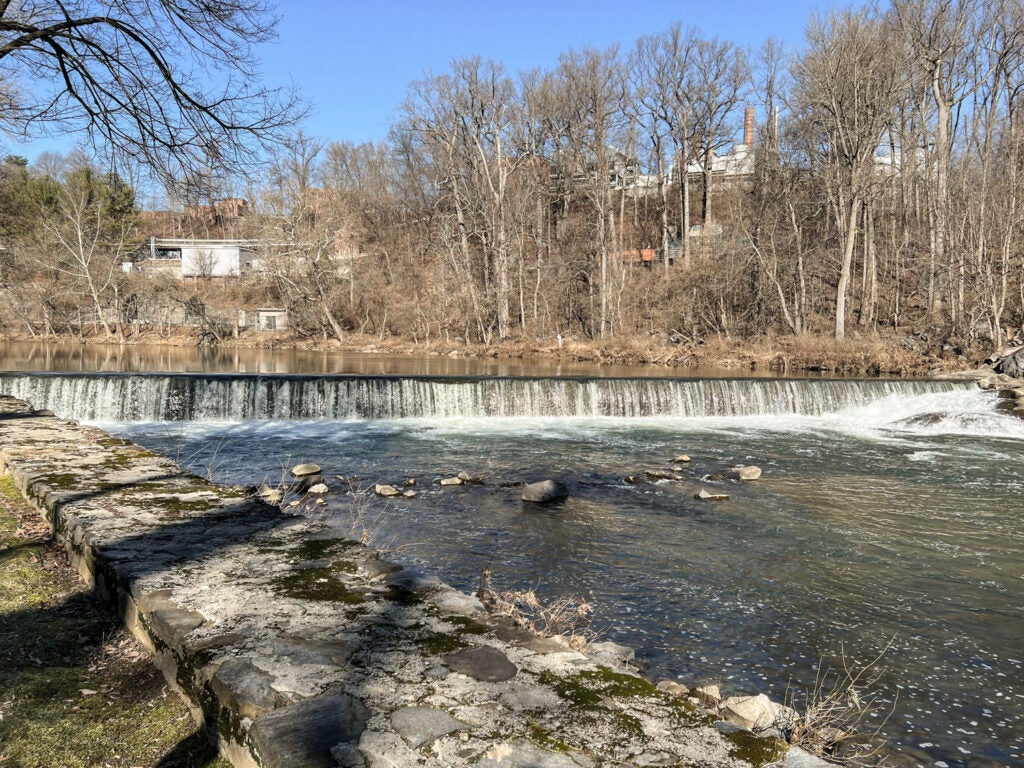
Restoring river flow
Brandywine Creek — also called the Brandywine River — is the largest source of drinking water in Delaware. Since the Clean Water Act was enacted in 1972, there have been a number of efforts to clean up legacy contaminants, such as PCBs and chlorinated pesticides, in an effort to make the waterway more fishable and drinkable.
Researchers say fish such as American shad are returning to the Brandywine. However, populations of the nation’s so-called “founding fish” are still close to record lows in eastern North America because of a history of overfishing, poor water quality and limited spawning habitats.
American shad live in the ocean for much of their life, but return to the freshwater rivers of their birth every four to five years to spawn. However, dams prevent the fish from migrating and reproducing.
After the city of Wilmington removed a Brandywine dam in 2019, University of Delaware scientists discovered American shad returning to the area to reproduce. One fish the researchers tracked even made its way to Nova Scotia, Canada, and back, said assistant professor Ed Hale, who helped lead the research.
“[Dams interrupt] normal behaviors associated with animals and organismal level behaviors, but also with the flow of energy,” Hale said. “It’s really pretty cool that the year after we remove a dam, [we] actually see that natural function.”
Flood protection
In addition to improving fish passage, scientists say dam removal is sometimes necessary to reduce the impacts of storm flooding.
Removing dams that are damaged or falling apart is the top priority, said the University of Delaware’s Gerald Kauffman, who has researched the Brandywine dams for 20 years. Unlike neighboring states, Delaware law does not require regular inspection of smaller dams, said Kauffman, who directs the university’s Water Resources Center.
One of the Brandywine River dams approved for removal is marred with a 10-by-30 foot hole. If it breaks during a major storm, an estimated 75 million gallons of water could topple downstream, Kauffman said. The researcher and professor said he’s particularly concerned about residents in northeast Wilmington — many of whom have yet to return to their homes after being flooded by Hurricane Ida in 2021.
“[Ida] was a lesson to me that we need to address [dams] now. Otherwise when the next [storm] comes down, it could be a catastrophe,” Kauffman said.
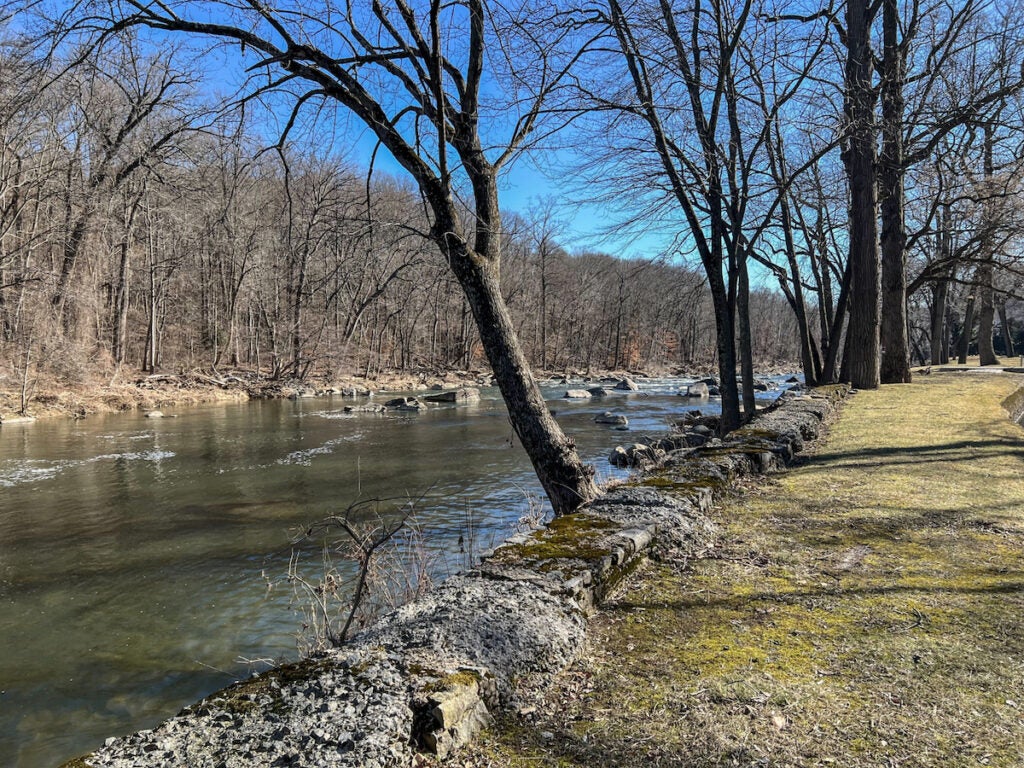
Intact dams built before the 1980s also have potential to lift already-rising water levels upstream during storms, he said, depending on a number of factors.
The dam behind Brandywine Falls appears to be in healthy condition, Kauffman said, which could mean the Army Corps of Engineers recommends stakeholders preserve it.
Brandywine Falls’ Ursomarso said he would like agencies to focus on other flood-reducing infrastructure efforts instead of dam removal.
“Let’s assume you took all the dams out of the river, and the river still flooded … that would be a tragedy,” he said.
Preserving history
Brandywine Falls residents say they’re not against fish passage efforts, but are fearful they might lose a piece of Delaware history.
The dam is a remnant of Joseph Bancroft, a businessman who established a cotton mill in the area in the 19th century, taking advantage of the Brandywine’s water power.
Joseph Bancroft & Sons Co. is considered to be the most significant and longest lasting textiles company on the Lower Brandywine, according to University of Delaware historians. By the early 20th century, it became one of the world’s largest textile finishers, introducing synthetic materials to the market. Bancroft Mills is listed on the National Register of Historic Places, and may also include the dam behind Brandywine Falls.
“I feel very impassioned about the history of the area, the famous families in this area,” said Brandywine Falls resident Jim Carrington.
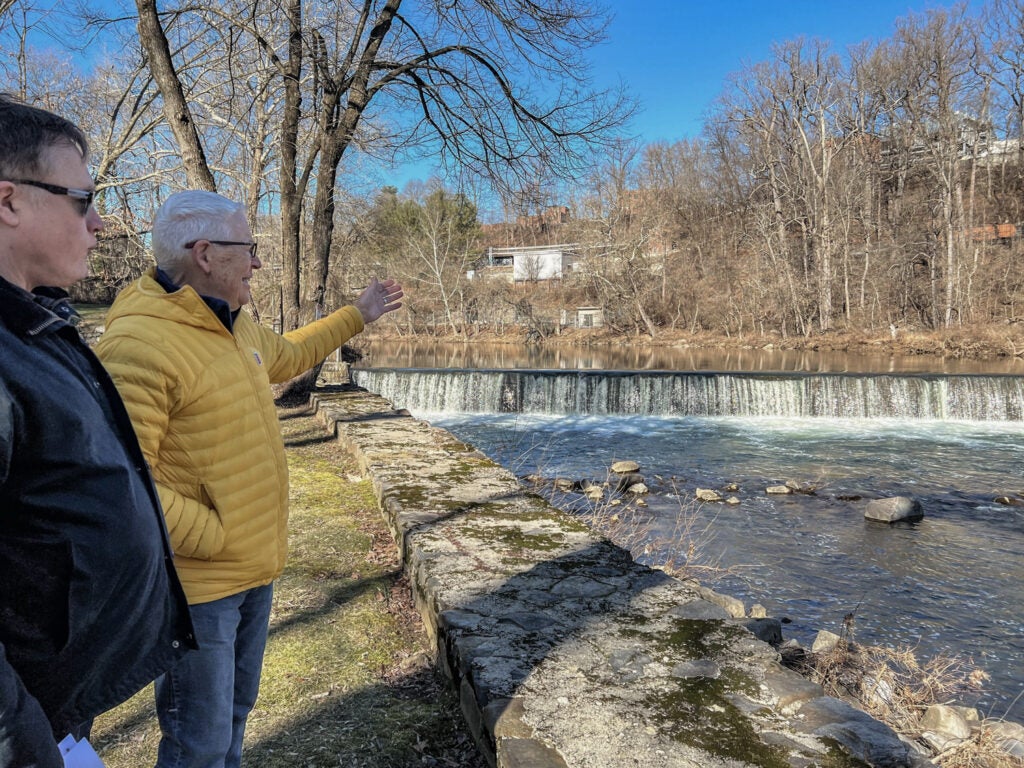
Bancroft Mills is listed on the National Register of Historic Places, and the dam behind Brandywine Falls is considered a “contributing element” of the historic district. The dam is eligible for an individual listing under the registry, but hasn’t been nominated, according to the Delaware Division of Historical and Cultural Affairs.
A national register listing does not preclude a dam from removal. However, agencies involved, such as the Army Corps of Engineers are required to consult state historians and other stakeholders to determine whether the dam should be preserved due to its historical significance. If they decide a dam should remain, alternatives such as a partial removal, or a rock ramp, can be considered.
In addition to evaluating the structural condition of the dam behind Brandywine Falls, the Army Corps of Engineers will also consider its historical significance, and other fish passage options.
Hagley Museum and Library owns four dams on the Brandywine that were previously operated by the DuPonts. The famous family located their gunpowder mills along the river to take advantage of water power. The museum’s leaders have not granted permission for dam removal because they’re pursuing a historical designation for them.
“The predominant use of the powder here at Hagley was used for things like westward expansion … and so it’s a really important chapter in the history of our country,” said Jill McKenzie, the museum’s executive director.
Hagley continues to use water power to this day to keep the museum’s 1870s machine shop off the electrical grid.
The museum is partnering with the Army Corps of Engineers to determine an alternative way to improve fish passage without removing the dams, such as potentially installing a rock ladder.
David Keller, head of the fisheries section at the Academy of Natural Sciences at Drexel University, said dam removal is sometimes the most effective way to improve fish passage. However, stakeholders must also evaluate potential risks, he said.
Invasive species, such as snakehead fish, could take advantage of expanded passage, Keller said.
“When you pull out a dam, you’re increasing connectivity, which is great for those native species that we want to restore. However, you’re increasing connectivity, so you’re going to be opening up areas upstream, making it more likely for the invasive species that are nearby to move into those habitats as well,” he said.
Any sediment behind dams should also be remediated prior to removal to prevent contamination from entering the waterway, Keller said. He believes agencies should prioritize dam removal efforts in areas that don’t pose any risk to endangered species.
As for Brandywine Falls, Kauffman said the debate boils down to who owns the river.
“Is it a small group that lives along it?” he said. “Who owns the river? The people own the river from bank to bank. Not any one group. So this is a bigger issue.”

Get daily updates from WHYY News!
WHYY is your source for fact-based, in-depth journalism and information. As a nonprofit organization, we rely on financial support from readers like you. Please give today.







